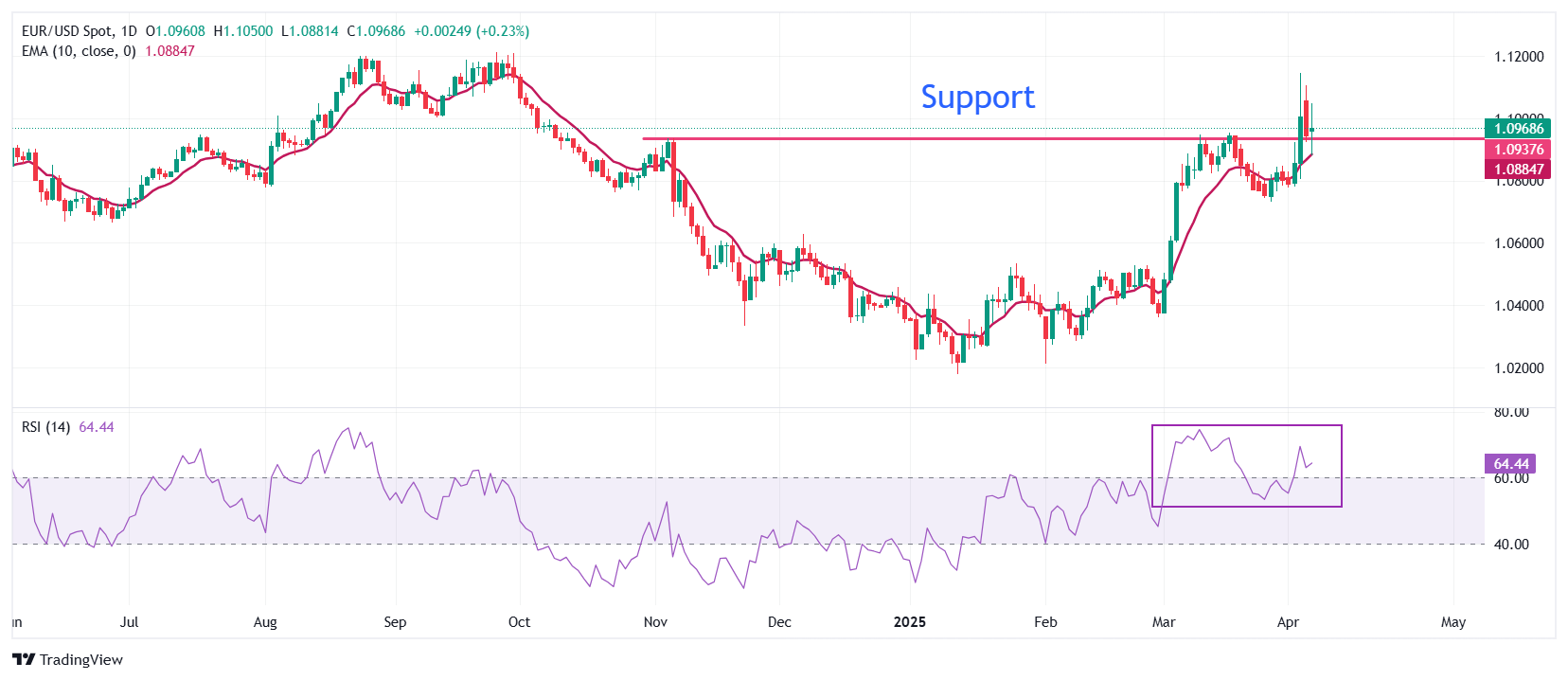- EUR/USD recovers to near 1.1000 as the US Dollar faces selling pressure, with Trump’s tariffs triggering US economic shocks.
- Analysts at JP Morgan expect the US economy to contract by 0.3% this year.
- ECB Schnabel expects more Trump tariffs to fuel uncertainty further.
EUR/USD reclaims the psychological level of 1.1000 in Monday’s European session after a weak opening to near 1.0880 earlier in the day. The major currency pair bounces back as the US Dollar (USD) slides in a risk-averse market environment, driven by the imposition of worse-than-expected reciprocal tariffs by United States (US) President Donald Trump on Wednesday. The US Dollar Index (DXY), which tracks the Greenback’s value against six major currencies, slumps to near 104.40.
Reciprocal tariffs announced by US President Trump have spooked global markets, resulting in equities melting down across the globe. However, Trump is not concerned about investors losing trillions from the world stock market and expects that higher levies will bring a lot of money to the US each year. “I don’t want anything to go down. But sometimes you have to take medicine to fix something,” Trump said while speaking at Air Force One over the weekend.
Theoretically, the appeal of the US Dollar strengthens amid heightening global tensions, given its safe-haven status. Still, it is underperforming as Trump’s tariffs have exposed the US economy to a recession.
Market experts have become increasingly concerned over the US economic outlook, assuming that the real burden of higher import duties will be on domestic importers. Investment banking firm JP Morgan has forecasted that the US economy could end the year with a 0.3% decline in the Gross Domestic Product (GDP) growth.
Also, Federal Reserve (Fed) Chair Jerome Powell stated on Friday that the President’s protectionist policies could lead to an increase in inflationary pressures and slower economic growth. Powell still supports interest rates remaining in the current range of 4.25%-4.50% as it is “too soon to say what will be the appropriate path for monetary policy.”
Daily digest market movers: EUR/USD gains as Euro outperforms
- A strong recovery move in the EUR/USD pair is also driven by the Euro’s (EUR) outperformance against its major peers at the start of the week. The Euro gains even though European Central Bank (ECB) officials have pushed back fears that tariff-driven inflation will be persistent in the Eurozone, allowing traders to raise bets supporting more interest rate cuts this year.
- ECB executive board member Isabel Schnabel said at an economic forum in northern Italy over the weekend that fresh tariffs by the US have made structural economic headwinds of the Eurozone even worse. Schnabel warned that higher import duties by the US have led to a “dramatic surge in uncertainty” and should brace for more ahead.
- The ECB has already reduced its key borrowing rates in both of the two policy meetings this year and is also expected to cut again on April 17. The central bank is likely to continue with its gradual monetary policy easing pace, which will push the Deposit Facility rate lower to 2.25%. Such a scenario will be unfavorable for the Euro.
- During European trading hours, Eurostat reported that Retail Sales grew at a slower-than-expected pace on a monthly basis in February. Retail Sales, a key measure of consumer spending, rose by 0.3%, slower than estimates of 0.5%, after remaining flat in January. On year, the consumer spending measure rose by 2.3%, stronger than expectations and the prior release of 2.3%.
- This week, the EUR/USD pair will be influenced by the US Consumer Price Index (CPI) data for March, which will be released on Thursday.
Technical Analysis: EUR/USD recovers from 1.0880

EUR/USD resumes its upward journey after a healthy correction from the six-month high of 1.1145 reached on Thursday to near 1.0880 on Monday. The major currency pair rebounds as the 10-day Exponential Moving Average (EMA) acts as major support around 1.0886. The pair aims to hold the key support of 1.0938 plotted from the November 5 high.
The 14-day Relative Strength Index (RSI) stays above 60.00, suggesting that the bullish momentum is intact.
Looking down, the March 31 high of 1.0850 will act as the major support zone for the pair. Conversely, the September 25 high of 1.1214 will be the key barrier for the Euro bulls.
Euro FAQs
The Euro is the currency for the 19 European Union countries that belong to the Eurozone. It is the second most heavily traded currency in the world behind the US Dollar. In 2022, it accounted for 31% of all foreign exchange transactions, with an average daily turnover of over $2.2 trillion a day.
EUR/USD is the most heavily traded currency pair in the world, accounting for an estimated 30% off all transactions, followed by EUR/JPY (4%), EUR/GBP (3%) and EUR/AUD (2%).
The European Central Bank (ECB) in Frankfurt, Germany, is the reserve bank for the Eurozone. The ECB sets interest rates and manages monetary policy.
The ECB’s primary mandate is to maintain price stability, which means either controlling inflation or stimulating growth. Its primary tool is the raising or lowering of interest rates. Relatively high interest rates – or the expectation of higher rates – will usually benefit the Euro and vice versa.
The ECB Governing Council makes monetary policy decisions at meetings held eight times a year. Decisions are made by heads of the Eurozone national banks and six permanent members, including the President of the ECB, Christine Lagarde.
Eurozone inflation data, measured by the Harmonized Index of Consumer Prices (HICP), is an important econometric for the Euro. If inflation rises more than expected, especially if above the ECB’s 2% target, it obliges the ECB to raise interest rates to bring it back under control.
Relatively high interest rates compared to its counterparts will usually benefit the Euro, as it makes the region more attractive as a place for global investors to park their money.
Data releases gauge the health of the economy and can impact on the Euro. Indicators such as GDP, Manufacturing and Services PMIs, employment, and consumer sentiment surveys can all influence the direction of the single currency.
A strong economy is good for the Euro. Not only does it attract more foreign investment but it may encourage the ECB to put up interest rates, which will directly strengthen the Euro. Otherwise, if economic data is weak, the Euro is likely to fall.
Economic data for the four largest economies in the euro area (Germany, France, Italy and Spain) are especially significant, as they account for 75% of the Eurozone’s economy.
Another significant data release for the Euro is the Trade Balance. This indicator measures the difference between what a country earns from its exports and what it spends on imports over a given period.
If a country produces highly sought after exports then its currency will gain in value purely from the extra demand created from foreign buyers seeking to purchase these goods. Therefore, a positive net Trade Balance strengthens a currency and vice versa for a negative balance.

